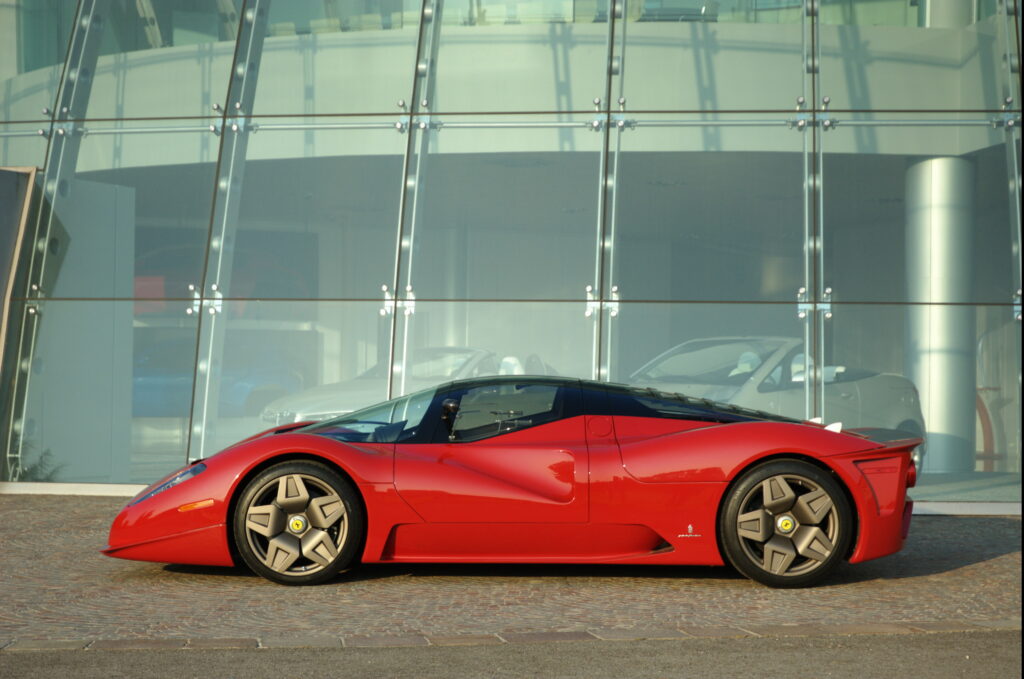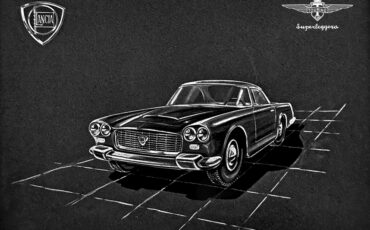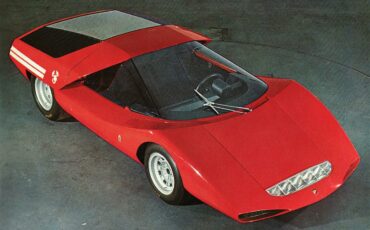
Imagine taking one of Ferrari’s most celebrated supercars, the Enzo, and reimagining it with a design that channels the golden age of 1960s endurance racing. Now, picture this vision brought to life by Pininfarina, one of the most revered names in automotive design. That’s exactly what James Glickenhaus, a passionate car collector and filmmaker, achieved with the Ferrari P4/5 by Pininfarina.
Unveiled to the public in 2006, the P4/5 is more than just a car; it’s an artistic statement, an engineering marvel, and a love letter to Ferrari’s racing history. With a modern powertrain, bespoke design, and a story as captivating as its curves, the P4/5 continues to enchant car enthusiasts worldwide. Let’s dive into its unique history, groundbreaking design, remarkable performance, and enduring legacy.
A Collector’s Dream Becomes Reality
In 2005, Glickenhaus approached Pininfarina with an audacious vision: to transform the Ferrari Enzo into a one-of-a-kind homage to Ferrari’s iconic “P” series endurance racers of the 1960s. The goal was to blend the evocative spirit of Ferrari’s racing past with the technological sophistication of a modern supercar.

Under the guidance of Andrea Pininfarina, Chairman and CEO of Pininfarina S.p.A., and Paolo Garella, then-Head of Pininfarina Special Projects and founder of M.A.T., a talented team embarked on this ambitious project. Ken Okuyama, Director of Pininfarina Styling, played a pivotal role in shaping the P4/5’s breathtaking exterior, while Jason Castriota contributed significantly to its design evolution. Together, they collaborated closely with Glickenhaus, creating a true masterpiece of automotive design.
This extraordinary effort came with an equally extraordinary price tag—approximately $4 million—but the result was worth every cent. The Ferrari P4/5 by Pininfarina would become one of the most celebrated bespoke automobiles of all time, capturing the imagination of car enthusiasts and collectors alike.
Design: A Perfect Fusion of Past and Present
The P4/5’s design is a tribute to Ferrari’s golden age of endurance racing while incorporating modern engineering and materials. The car’s lines were inspired by legendary racers like the Ferrari 330 P3/4, blending soft muscularity with contemporary aerodynamics.
Crafted entirely from carbon fiber, the Ferrari P4/5 is both lightweight and visually stunning. Its aerodynamic tapered front end emphasizes both performance and elegance, while the butterfly doors add a touch of drama. The rear is dominated by a teardrop-shaped transparent window, which serves as an engine cover and evokes the racing cars of the 1960s.
The 20-inch aluminum wheels are a perfect example of this fusion of modern technology and classic aesthetics. Milled from solid blocks of aluminum, these wheels are not only functional but also visually striking, showcasing the technical prowess involved in the car’s creation. The car’s lighting is another standout feature, with custom bi-xenon headlamps incorporating an innovative yellow and white LED system. This unique lighting setup serves both an aesthetic and functional purpose, blending performance with style.
As you move to the rear of the car, the ceramic-coated exhaust tips are a nod to vintage racing cars, designed to evoke the spirit of Ferrari’s racing heritage. These elements are a visual cue that this is no ordinary road car, but one that has been crafted with both performance and history in mind. The exposed aluminum and stainless steel hinges further enhance the P4/5’s industrial elegance, providing a modern contrast to the sleek carbon fiber body while underscoring the car’s meticulously engineered nature.
These design elements, from the wheels to the exhaust tips, are not just details—they represent the culmination of over 200 unique components developed specifically for the Ferrari P4/5. Each element was crafted to enhance the car’s performance, aesthetic appeal, and connection to Ferrari’s racing lineage, making it a true work of art on wheels.

Inside, the P4/5 reflects Glickenhaus’ personal vision. The interior was completely redesigned to include custom carbon-fiber seats, high-quality leather upholstery, and modern conveniences like climate control and a tablet-based navigation system. Every detail, from the materials to the ergonomics, was tailored to meet Glickenhaus’ and his family’s preferences, creating a personal touch rarely seen in automotive design.
Engineering Excellence
While its design pays homage to the past, the P4/5’s performance is firmly rooted in the present. Based on the Ferrari Enzo, the car retains the Enzo’s 6.0-liter V12 engine, which delivers an exhilarating 660 horsepower. It rockets from 0-62 mph (0-100 km/h) in just 3.0 seconds and reaches a top speed of 225 mph (362 km/h).

The P4/5 underwent extensive aerodynamic testing at Pininfarina’s Grugliasco wind tunnel facility. These tests resulted in a remarkable drag coefficient of 0.34, showcasing the team’s ability to blend aesthetics with functional performance. The car’s carbon-fiber construction further enhances its capabilities, reducing its weight to just 2,645 pounds (1,200 kilograms)—an impressive 617 pounds (280 kilograms) lighter than the Ferrari Enzo.
A Legacy of Collaboration
What sets the Ferrari P4/5 apart is the close collaboration between Glickenhaus and Pininfarina’s design team. Glickenhaus was deeply involved in every stage of the project, from the initial sketches to the final wind tunnel tests. His input was instrumental in creating a car that reflected not only Ferrari’s legacy but also his personal passion for automotive history.

Ken Okuyama, reflecting on the project, emphasized the elegance and simplicity of the P4/5’s design, which he described as a modern interpretation of Pininfarina’s timeless style. This harmonious relationship between client and creator resulted in a car that seamlessly combines artistic vision with engineering excellence.
Awards and Global Acclaim
The P4/5’s debut at the 2006 Pebble Beach Concours d’Elegance was met with universal acclaim. Automotive enthusiasts and industry insiders praised its design, innovation, and execution. Over the years, the P4/5 has continued to receive accolades, including recognition at prestigious events and awards for design and engineering excellence.
Notably, the car was honored with the Most Beautiful Car in the World award, a testament to its enduring aesthetic appeal and the craftsmanship that went into its creation.
The Enduring Legacy of the Ferrari P4/5
For many Ferrari enthusiasts, the Ferrari P4/5 by Pininfarina is what the Ferrari F80 could have been—a stunning blend of Ferrari’s racing heritage and modern design. With its aggressive lines and striking presence, the P4/5 stands as a timeless icon that still looks futuristic today.
Created by James Glickenhaus with the expertise of Andrea Pininfarina and Ken Okuyama, the P4/5 is more than just a car. It’s a tribute to Ferrari’s history, a showcase of innovation, and a masterpiece of bespoke design. Its unique combination of performance, artistry, and cutting-edge engineering continues to captivate car enthusiasts, securing its place as one of the most iconic vehicles ever created.
The Ferrari P4/5 is a perfect example of what’s possible when passion meets precision, and it remains a symbol of automotive excellence that continues to inspire.
















